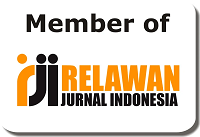Simulation Model Design of VHF Omni-Directional Range (VOR) Based on Microcontroller
DOI:
https://doi.org/10.31963/elekterika.v21i1.4754Keywords:
VOR Simulator, DME, Bluetooth, MicrocontrollerAbstract
The process of giving directional information to assist airplanes in making an accurate landing at the airport of destination is known as aviation navigation. The VHF Omnidirectional Range is a crucial navigation tool for guiding planes to the airport (VOR). Since it costs a lot of money to learn how to fly an airplane, a VOR simulator was developed that can mimic the movement of an aircraft passing through the VOR. The simulation that was produced is a prototype that sends and receives signals to the aircraft utilizing an antenna and microcontroller as supporting hardware. The VOR/DME flight navigation system is constructed in this study using mathematical modeling; a formulation representing the essential features of the system is expressed as a set of connected variables. The ESP32 module that powers the system serves as a DME by sending out Bluetooth radio signals. where one ESP32 module serves as a DME object (moving DME) and three ESP32 modules serve as DME stations (ground DME). Information on the distance between the DME station and the DME object will be communicated using the MQTT protocol, and this data will be processed using the trilateration method to predict the location and movement of the DME object. The measurement accuracy at DME station 1, DME station 2, and DME station 3 are 99.52%, 99.92%, and 99.98% respectively. The enhanced capabilities to estimate the position of objects observed from different directions or omni-directionally on a two-dimensional scale are made possible by the performance results of combining the performance of three ESP32 devices as Distance Measurement Equipment (DME).References
A. Sahputra et al., “Implementasi monitoring parameter localizer berbasis internet of things,” vol. VII, no. 3, 2021.
K. RI, UU No.1 Tahun 2009.pdf. Indonesia, 2009, pp. 1–66.
W. Ariyanti, “PEMODELAN DAN SIMULASI INSTRUMEN PESAWAT VOR / DME ( VHF OMNI-DIRECTIONAL RANGE / DISTANCE MEASURING EQUIPMENT ) SEBAGAI PERALATAN NAVIGASI UDARA ( NAVAIDS ) PADA PESAWAT TERBANG,” |Jurnal Teknologi Informasi dan Komunikasi, vol. 9, no. 1, pp. 25–35, 2019.
A. D. Rachmanto, “SIMULATOR PESAWAT MELEWATI VHF OMNIDIRECTIONAL RADIO RANGE ( VOR ),” Jurnal Teknologi Kedirgantaraan, vol. 5, no. 1, pp. 36–49, 2020.
N. W. Sari and B. Yulianti, “Analisa Fungsi T-DME Sebagai Pengganti Fungsi Outer Marker Runway O7 L Bandara Soekarno Hatta,” vol. 7, pp. 49–54, 2018.
C. Utomo, “Doppler Very High Frequency Omni-directional Range 3 (DVOR) AWAV RB51D Sebagai Salah Satu Alat Navigasi Udara Di Bandara Ahmad Yani Semarang,” Jurnal, Universitas Diponegoro, Semarang, 2013.
F. Haryadi, “Analisis Perangkat Navigasi Model 1150 Doppler Very High Omni-Directional Range (DVOR) Untuk Memandu Pesawat Menuju Bandara Tujuan”,” Jurnal, Akademi Teknik Telekomunikasi Sandhy Putra Puwokerto, Purwokerto, 2013.
E. Wahyudi, W. Pamungkas, B. Saputra, P. Studi, and T. Telekomunikasi, “ANALISIS LINK BUDGET ANTENA SIDEBAND DOPPLER VERY HIGH OMNI-DIRECTIONAL RANGE ( DVOR ),” Jurnal Infotel, vol. 5, no. 1, pp. 1–9, 2013.
Ahmad Daili, “PENERAPAN METODEPEMBELAJARAN SIMULASI UNTUK MENINGKATKAN PERCAYA DIRI DAN PRESTASI BELAJARNo Title,” Jurnal Ilmiah Teknologi Pendidikan, vol. 12, no. 1, pp. 68–74, 2022.
R. C. N. Santi, “Perancangan Interaksi Pengguna (User Interaction Design) Menggunakan Metode Prototyping,” Jurnal Teknik Informatika, vol. 9, no. 2, 2016.
M. Arif, Pemodelan Sistem. Deepublish, 2017.
E. Lolang, “HIPOTESIS NOL DAN HIPOTESIS ALTERNATIF,” JURNAL KIP, vol. 3, no. 3, pp. 685–695, 2015.
F. J. Gravetter, L. B. Wallnau, L.-A. B. Forzano, and J. E. Witnauer, Essentials of statistics for the behavioral sciences. Cengage Learning, 2020.










